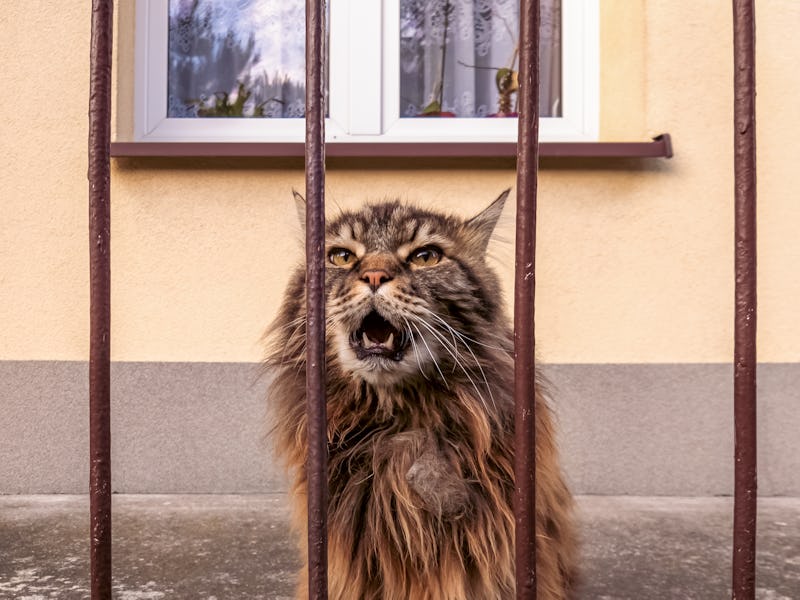Letting your cat go outside could spread “life-threatening” parasites — new research
Rabies has also been linked to outdoor cats.

For decades, scientists have warned that ecologically destructive activities increase the risk of diseases spilling over between wildlife and human populations. Examples of these drivers include climate change, habitat loss, wildlife trafficking, environmental contamination, expansion of anthropocentric activities, and invasive species introduction.
Domestic animals also contribute to the movement of diseases between species. Free-roaming domestic animals, like cats, can facilitate the spread and transfer of diseases, impacting both humans and wildlife.
Infectious parasites
Free-roaming cats — which include feral, stray, and house cats — present a particularly compelling case because of their large population sizes and their central role in the life cycle of a parasite called Toxoplasma gondii (T. gondii) that infects both wildlife and humans. Most people may have only heard of toxoplasmosis from their doctors during pregnancy or in articles on “brain-altering” parasites.
However, T. gondii is one of the most common zoonotic parasites globally and is estimated to affect about 30 to 50 percent of the global human population. T. gondii infections can have severe and life-threatening consequences; especially for immunocompromised people and infants infected during pregnancy.
Pregnant women are often advised to avoid interacting with cat feces because of the risk posed to their unborn children.
Toxoplasma gondii forms a permanent resting tissue cyst in the muscle or nervous tissue of a host, so even healthy infected people are impacted. Chronic toxoplasma infections have been linked with illnesses including degenerative neurological diseases, schizophrenia, and brain cancer.
Domestic cats or wild felids — like lions, jaguars, or cougars — intermittently excrete millions of T. gondii eggs (called oocysts) into the environment through their feces. These oocysts persist under favorable conditions for years in water and soil, with the capacity for long-distance dispersal.
If any warm-blooded animal ingests an oocyst, it can become infected with T. gondii. This can happen if a person or animal ingests oocysts in contaminated water or food, or through eating another animal that has already become infected.
Spreading diseases
Although both wild felids and domestic cats are sources of toxoplasma, domestic cats outnumber wild felids by several orders of magnitude. We recently tested whether mammals living in environments with greater densities of domestic cats would show higher infection rates of T. gondii.
While there are no global data sets showing domestic cat densities, domestic cats are closely associated with humans, and therefore, measures of human population density can act as a surrogate for the density of free-roaming cats. Using data from over 200 studies, we demonstrated that indeed, wildlife living in areas of higher human density had higher infection rates of T. gondii.
We concluded that this higher infection rate occurred due to a combination of two phenomena: high densities of free-roaming domestic cats producing infected feces, and the loss of natural habitats. Natural ecosystems have important roles in filtering, sequestering, and removing T. gondii and other pathogens from human, livestock, and wildlife exposure pathways. Breaking the lifecycle by preventing cats from hunting and landscape restoration are key preventative measures.
If wildlife has an increased risk of exposure to T. gondii in certain areas, then humans and livestock can also be unintended targets. Public health researchers have shown this repeatedly by sampling soil, vegetable gardens, and playgrounds.
Rabies risk
Rabies is another disease whose risk is increased by free-roaming cats. In the United States, cats are the most common rabies-positive domestic species, with cats posing two-and-a-half times the rabies exposure risk compared to bats in Pennsylvania. In Canada, we recently found similar public health concerns of free-roaming cats when we examined patterns of rabies submissions of bats in Canada.
In Canada, free-roaming cats were associated with 10 times more bats being submitted for rabies testing compared to indoor cats. In fact, in our dataset, there were five records of free-roaming cats bringing bats into the house that subsequently were found to be rabies positive. This hunting activity by cats is obviously dangerous for people in the household and is a very simple explanation for cases of cryptic rabies infections (rabies cases without an identifiable source).
In areas with large numbers of free-roaming cats predating bats, the risk that a human will be exposed to rabies is expected to increase.
This risk is directly proportionate to the frequency of free-roaming cats killing bats, which is unfortunately common. Single cats have been known to kill a hundred bats in a week.
In our dataset, one free-roaming cat killed nine endangered little brown bats in one month, with another record of a cat killing 14 bats in a single evening. Many bat populations have undergone severe declines, especially due to an introduced fungal disease. Bats are long-lived with low reproduction, so this additional source of mortality can severely impact bat populations.
Since cats only bring home 20 percent of what they kill, prey returns and rabies submissions only provide a tiny glimpse of the true cat predation rates. It is therefore apparent that although natural rabies prevalence in bats is low — less than one per cent — in areas with cats killing large numbers of bats, rabies exposure risks will increase.
Protecting health and wildlife
There is broad consensus among veterinarians, ecologists, public health experts, and animal rights activists that free-roaming by domestic cats is detrimental to feline welfare, wildlife welfare, conservation, and human health. Wildlife has the same capacity for distress and pain as domestic animals and performs irreplaceable ecosystem services with tangible economic benefits, making their predation unjustifiable from an ethical or economic perspective.
Free-roaming cats suffer from increased mortality through traumatic injury, disease, neglect and abandonment. This marginalization of cats needs to be replaced with progressive enrichment resources and responsible management that do not foster an inhumane and biased disregard for feline welfare standards, wildlife welfare, conservation, and human health.
David Lapen, the research scientist with Agriculture and Agri-Food Canada, co-authored this article.